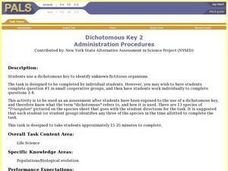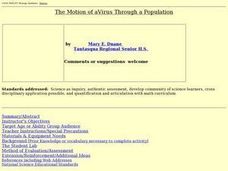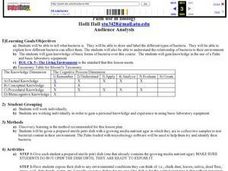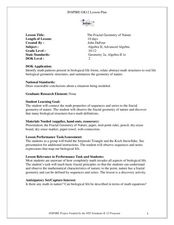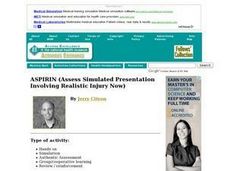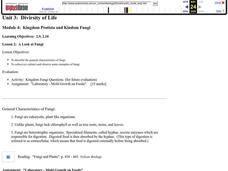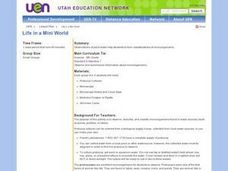It's About Time
Diversity in Living Things
How diverse is the world we live in compared to the way things used to be? Young biologists explore diverse organisms and relate the structure of each organism to its ability to survive in our current environmental conditions....
Nuffield Foundation
Effect of Size on Uptake by Diffusion
Cell size is limited by the surface area to volume ratio, but why is this true? Scholars measure the surface area and volume of cubes before placing them into liquid. After a set amount of time, they measure the uptake by diffusion for...
Nuffield Foundation
How Good is Your Toilet Paper?
You'll never forget the importance of toilet paper and hand washing ever again. Scholars perform an experiment to model the transfer of microbes in the bathroom. They perform three trials to test the transmission of yeast using their...
Nuffield Foundation
Measuring Rate of Water Uptake by a Plant Shoot Using a Potometer
How quickly does a plant transpire? Learners explore this question through measuring water uptake with a potometer. They time the movement of a bubble a set distance to understand the motion and rate of speed.
Curated OER
Chemosynthesis in the Classroom
Young scholars observe the development of chemosynthesis in bacterial communities. In this bacteria lesson students explore that chemosynthesis is and how it is relevant to biological communities.
Curated OER
Seed Detectives
Young scholars examine seed coats. In this biology lesson, students look at pictures of magnified seed coats, then use hand-help magnifiers or microscopes to look at seed coats on their own.
Curated OER
Using the senses
Students use their senses to compare a frog and a hamster. In this animals comparison lesson plan, students get into groups and observe, smell, feel, and listen to what their animals are like, and classify them into categories.
Curated OER
How a Seed Grows and Who Grows It
First graders explore biology by viewing PowerPoint presentations in class. In this plant life instructional activity, 1st graders identify the life cycle of a plant and how to properly plant a seed outside. Students view a movie about...
Curated OER
Structural and Behavioral Adaptations
Learners participate in a role playing lab that allows students to experience how different beak adaptations play a role in the type of food the animal can eat, therefore playing a role in the survival of the species.
Curated OER
Dichotomous Key 2
Students use a dichotomous key to identify unknown fictitious organisms in an assessment designed to be used after a discussion on the use of a dichotomous keys has occurred. Follow up questions about key included.
Curated OER
The Motion of a Virus Through a Population
Students test the factors that influence the rate at which a virus spreads through a population. They complete a lab activity then discuss data collected and review and answer a set of questions.
Curated OER
Worms Crawl In and Do Lots of Things
Young scholars observe the aquatic segmented worm, Lumbriculus varigatus and the life processes. They explore the processes of nutririon, transport, regulation, locomotion, and removal of wastes.
Curated OER
Palm Use in Biology
Young scholars view bacteria through a microscope. They draw and label the bacteria using microbiology software loaded onto their Palms.
Curated OER
Wait, They Can do it by Themselves?
Learners recognize the concepts of evolution and natural selection as well as cladistics and phylogenetics. They observe the process of regeneration in a sea anemone to simulate asexual reproduction.
Curated OER
The Fractal Geometry of Nature
Pupils identify patterns found in nature. In this algebra lesson, students model situation in nature using fractals. They investigate biological geometric structures and draw conclusion based on geometric concepts.
Curated OER
What Is Your Explanation for the Evidence?
Students encounter an interactive computer program activity designed as a diagnostic of student beliefs related to the theory of evolution. Students process the Hypercard cascades structured around a set of biological topics related to...
Curated OER
ASPIRIN (Assess Simulated Presentation Involving Realistic Injury Now)
Pupils integrate biology and chemistry into a medical framework. They nterpret observations and data and evaluate their hypotheses in the light of the data obtained.. They make appropriate diagnosis and recommend treatment.
Curated OER
2005 Submarine Ring of Fire Expedition: What's for Dinner?
Students compare and contrast photosynthesis and chemosynthesis as sources of primary production for biological communities, and describe sources of primary production observed in biological communities associated with volcanoes of the...
Curated OER
Introduction of the Human Heart
Fifth graders make their observations about the structure of the human heart. Students trace the flow of blood through the human heart. They touch a model of the human heart, 5th graders read aloud a handout that is found in their...
Curated OER
Creating a Dichotomous Key for Families of Idaho Butterflies
Young scholars are shown how to use the butterfly section of the Digital Altals of Idaho. They discuss how to make a dichotomous key. Students use their skills of observation and recognize defining characteristics that distinguish...
Curated OER
Diversity of Life
Students study fungi and its characteristics. In this fungi lesson students collect and observe fungi then answer questions on what they saw.
Curated OER
Structure and Function of Seeds
Students study the functions of seeds. In this biology lesson plan, students observe the structure of a seed as they show the function of the cotyledons in providing nourishment to the plant during the early times after germination.
Curated OER
Life in a Mini World
Sixth graders observe, describe, and classify microorganisms found in water sources. In small groups, they make their own slide, observe the Protozoa under a microscope, and record and classify the microorganisms.
Curated OER
A Natural Habitat: What, How and Why
Students understand what a habitat is. They determine why a habitat is important to our environment no matter where it is located. Students observe and recognize natural habitats in their surroundings.











